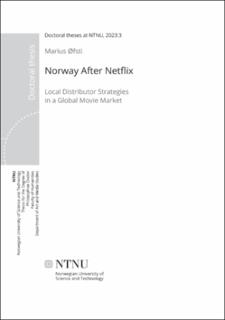| dc.contributor.advisor | Engelstad, Audun | |
| dc.contributor.advisor | Bakøy, Eva | |
| dc.contributor.author | Øfsti, Marius | |
| dc.date.accessioned | 2023-01-20T14:04:29Z | |
| dc.date.available | 2023-01-20T14:04:29Z | |
| dc.date.issued | 2023 | |
| dc.identifier.isbn | 978-82-326-5326-3 | |
| dc.identifier.issn | 2703-8084 | |
| dc.identifier.uri | https://hdl.handle.net/11250/3045010 | |
| dc.description.abstract | Norsk sammendrag
Da Netflix kom til Norge i 2012 begynte en ny æra i digital filmdistribusjon. Nærmest over natta tapte den norske filmbransjen titalls millioner i inntekter fra hjemmemarkedet, og for de lokale distributørene viste framveksten av en global og digital amerikansk filmbransje seg som en eksistensiell trussel. Ved hjelp av kvantitative og kvalitative metoder undersøker denne avhandlingen hvordan norske filmdistributører tilpasset sine strategier og sin funksjon da spredningen av film ble digital og global.
Denne avhandlingen presenterer et nytt teoretisk rammeverk, «cultural industries functions» (kulturindustrienes funksjoner), og benytter dette for å vise hvordan den lille norske filmbransjen ble påvirket av de globale endringene i hvordan film ble spredt. Avhandlingen finner at digitaliseringen av filmbransjen ikke bare førte til et tap av inntekt for norske filmdistributører. Digitaliseringen brakte også med seg endringer i den amerikanske filmbransjens behov og prioriteringer, som kom til å true de norske film distributørenes grunnleggende funksjon.
Ved hjelp av kvantitative og kvalitative metoder avdekker avhandlingen sentrale handlingsmønster og posisjoner blant norske distributører, og analyserer den senere tidens endringer. Avhandlingen finner at som svar på dette tapet av både inntekt og potensiell funksjon ble norske filmdistributører mer avhengige av norske filmer. Selv om utenlandske filmer stadig er en tryggere og mer forutsigbar inntektskilde, har disse blitt stadig vanskeligere å få rettigheter til samtidig som de har mistet verdi i hjemmemarkedet. SF Studios og Nordisk Film Distribusjon, de største distributørene innen norsk film, økte også graden av vertikal integrasjon gjennom oppkjøp av produksjonsselskap. Dette bidrar imidlertid til større forskjeller mellom de norske distributørene der de mindre mister tilgangen til både film og markeder. | en_US |
| dc.description.abstract | English abstract
When Netflix came to Norway in 2012, the service ushered in a new era of digital film distribution. The Norwegian film industry lost millions of home entertainment revenue almost overnight and for local distributors the emergence of a global and digital American film industry posed an existential threat. Using quantitative and qualitative methods this thesis examines how Norwegian film distributors adapted their strategies and their function when film dissemination became digital and global.
The thesis Norway After Netflix presents a new theoretical framework, the cultural industries functions, and employs this framework to show how the small Norwegian film industry was affected by global changes in the way movies are being distributed. The thesis finds that the digitalisation of the film industry not only led to reduced revenue for Norwegian distributors. The digitalisation also brought a shift in needs and priorities for the American film industry that threatened the very function of the traditional Norwegian film distributor.
Using quantitative and qualitative methods the thesis examines the strategies of Norwegian film distributors after 2008 and identifies key patterns and positions among Norwegian distributors as well as analysing recent shifts. The thesis finds that in response to this loss of not only revenue, but also a potential loss of function, Norwegian distributors began relying more on local titles. While foreign titles remained a far more predictable source of income, they became increasingly difficult to acquire cinematic rights to and they were less valuable in home entertainment markets. SF Studios and Nordisk Film, the "local majors" also increased their level of vertical integration by acquiring production companies. However, this also contributes to a widening gap of "circulation power" between the "high-resource" and "low-resource" distribution companies in Norway, as the smaller companies lose access to both movies and markets. | en_US |
| dc.language.iso | eng | en_US |
| dc.publisher | NTNU | en_US |
| dc.relation.ispartofseries | Doctoral theses at NTNU;2023:3 | |
| dc.title | Norway After Netflix. Local Distributor Strategies in a Global Movie Market | en_US |
| dc.type | Doctoral thesis | en_US |
| dc.subject.nsi | VDP::Humaniora: 000::Kulturvitenskap: 060 | en_US |
